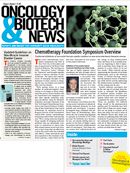Publication
Article
OBTN
Updated Guidelines on Non-Muscle Invasive Bladder Cancer
Each year, more than 60,000 people are diagnosed with bladder cancer
The American Urological Association (AUA) has updated its guideline on the Management of Non-muscle Invasive Bladder Cancer. Each year, more than 60,000 people are diagnosed with bladder cancer, which has been linked to a number of risk factors, including cigarette smoking and exposure to hazardous chemicals.
The updated Guideline reviews a number of current treatments, including transurethral resection of bladder tumors (TURBT) and the use of chemotherapeutic agents (such as mitomycin C) and immunotherapeutic agents (such as bacillus Calmette-Guerin [BCG]) in conjunction with TURBT. The panel also reviewed the efficacy of chemotherapy vs. immunotherapy in treating these noninvasive tumors, and the use of these agents in single induction courses compared with use as maintenance therapies. The Guideline also concludes:
• Accurate clinical staging upon which to base treatment decisions is critically important. The panel recommends performing a repeat TURBT prior to intravesical therapy in situations where there is high grade T1 disease without muscularis propria in the specimen and in select cases even when there is muscle present.
• A single, postoperative instillation of a chemotherapeutic agent may decrease recurrence risk in patients with superficial disease who have undergone uncomplicated resection of the tumor(s).
• There is no clear superiority of immunotherapy over chemotherapy for low-risk disease. Induction courses of either intravesical chemotherapy or immunotherapy (BCG) should be administered in patients with an increased risk of tumor recurrence but low risk of progression.
• An induction course of mitomycin C in conjunction with maintenance therapy enhances the effectiveness of the drug in preventing recurrence, however, no determinations have been made in regard to optimal maintenance dose, schedule, or duration.
Many of the accepted studies used to develop this Guideline and algorithms did not provide stratified outcomes data, and little data were available in regard to progression and survival. As a result, the panel felt the lack of data needs to be addressed and corrected; the Guideline includes a discussion of future research needs and the optimal reporting of bladder cancer data.
“Bladder cancer affects thousands of people each year and, as the incidence of the disease rises, it is increasingly important that clinicians better understand how this disease progresses and how to stop it,” said Craig Hall, MD, chair of the panel that developed the Guideline. “We may know more than ever about the disease’s clinical behavior and molecular biology, but we need a larger body of strong research in order to educate physicians and make treatment recommendations.”
Adapted from materials provided by American Urological Association.
